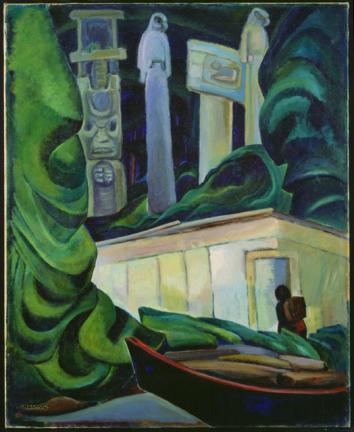Chapter Twenty-seven Salal

|
|
Indian Hut, Queen Charlotte Islands, oil on canvas, 1925-35, 101.6 x 82.6 cm. National Gallery of Canada, Ottawa,
#15470, Vincent Massey Bequest, 1968. Online image source: Cybermuse.
|
She stepped up to the dais. When she heard herself begin the lecture, her voice sounded thin and distant, as if her ears were plugged with wax.
"My object in making this collection of totem pole pictures has been to depict these striking, monumental relics in their original settings. I wish to make a tribute to the inventiveness of the art and the dignity of the way of life of the province's first people....
"Most Westerners transplanted their ideas about art from the time of European migration and haven't changed them, yet our landscape demands a new style. Our isolation from art centers should make it easier for us to be ourselves, to derive our inspiration from the land and the art of its first peoples....
"There's one style that does belong, and that's the original art of Canada's West Coast done by tribal carvers. The oldest art in Canada and it's the most modern in character. For the native artist, the principles of exaggeration and distortion are methods to express the inner nature of animal and human figures, to find the spirit of a thing. And it is these principles that I am exploring in my current work....
"I love these places with all my being, and the art, and the fine people I met. They can teach us many things." She saw several heads turn and some scowls in the audience.....
"I glory in our magnificent West, and want to celebrate and preserve the memorials of its first greatness. These poles, so full of dignity, should be as important to Canadians as ancient Celtic relics are to the English. In only a few more years, they will be gone forever which is why I want to complete my collection while there is still time."